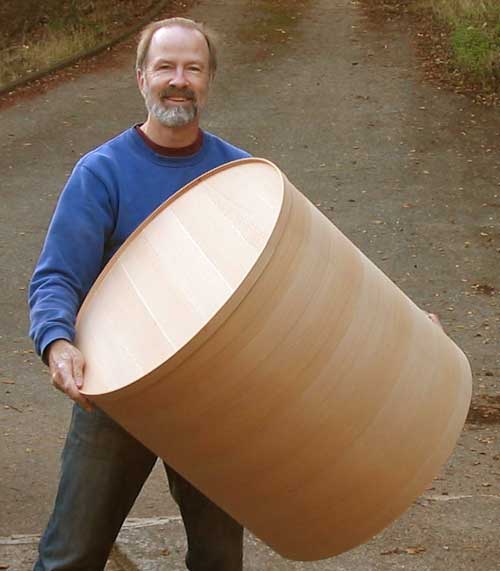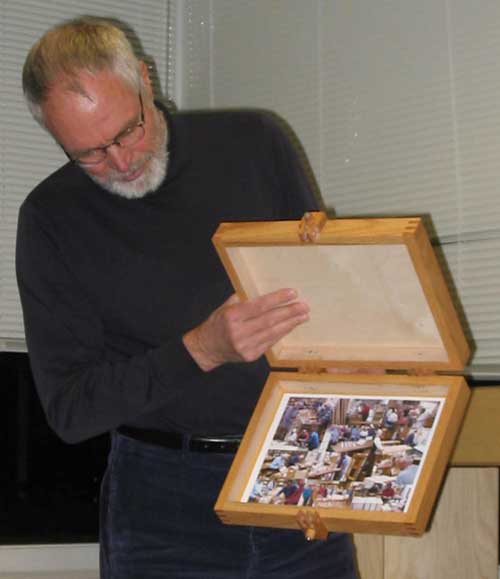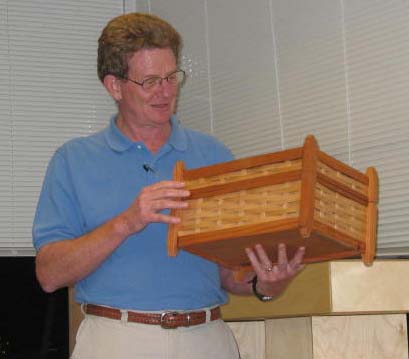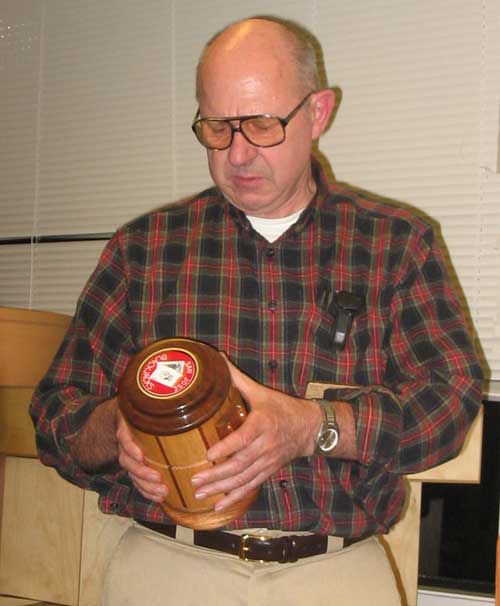
Last meeting
![]()
Our November meeting started as usual with Announcements.
Neil White our Silent Auction guru described the two items on display: a box of used 4" metal ducting from Craig Mineweaser and sets of wood for making boxes donated by Arnold Champagne.
Frank Ramsey announced that at the December meeting members will have the opportunity to talk about their favorite tool. A sign up sheet was passed around.
Stan Booker has some Maple bench tops available for $50 each. He also has some Winton vices for $55. He also gave us a brief description of his Tools For Africa trip. He and his party took over 200 pounds of tools to Africa for donation to schools and vocational training programs. They have more tools to send and are looking for volunteers to pay for the postage on 5 lb. shipments. Several club members donated shipping money. He will give us a more in-depth talk at the December meeting.
Frank Taylor donated sets of wooden periscope parts to be sold by the club. Great grandfathers get a set for free. The granite sanding blocks donated to the club by John Blackmore can be purchased for $1 each.
Per Madsen has compiled a list of prospective meeting speaker candidates for 2007. It is impressive. See Per if you are interested in reviewing the list. If you have suggestions for meeting subject matter contact Per at permads@comcast.net or 415 928-4509. Do this as soon as possible so that he can complete his planning.
Dan Goodman, the club librarian is selling old Fine Woodworking issues for $1 each. He brings many items to the meetings. If you want a list of library materials, it is available on the club website or contact Dan for a list or a specific item which he can bring to the next meeting. Dan can be reached at dan_m_goodman@yahoo.com or 415 826-4205.
Eric McCrystal announced that Woodcraft is sponsoring a Yeung Chan weekend workshop on Dec 10 and 11. The cost is $250. In addition, Eric said he had been contacted by the son of a woodworker who is retiring. The father is a tool and wood collector who is cleaning out. He has several Shopsmiths and three storage units of wood to remove. Contact Woodcraft if you are interested.
Mark Rand, our esteemed club treasurer reminded the membership that DUES ARE DUE NOW. He also held up the empty refreshments cash box and reminded everyone that if you eat or drink you are expected to make a donation. Several members stopped eating and hid their beverage cups. The dues also started pouring in with many of them in cash. Mark lost his head and bet it all on Saw Stop in the 5th at Golden Gate Fields and lost it all.
Tony Fanning announced that display items from the Woodworking Show were available to be picked up in the back of the meeting room.
Arnie Champagne has several woodworking benches for sale. Some are made of the famous Holy Oak.
CJ Riser described the plans being made for next month's Pot Luck Dessert Meeting to be held at the Redwood City Senior Center. An email will be sent to the membership and those people bringing desserts are requested to sign up and list their desserts so that we minimize duplications. There will be three presentations at this meeting: Bill Henzel will talk about Habitat for Humanity projects in Asia, Stan Booker will talk about his African adventures and there will be a forum on Tool Favorites.
Election of Club Officers:
The annual election of club officers was conducted by Neil White. There was a bitter fight for several spots but as usual money won out. The winners spent an average of $1.22 for advertising. The present officers were all re-elected.
A number of guests were present and were asked to introduce themselves. We were only able to get particulars on Gary Roldan from Redwood City. Bob Hulgan encouraged him to come. He is interested in box making, finish carpentry. Wood finishing and restoration. There were also two Toms, Bob, Jason and James. A big welcome was given to all.
Tech Talks:
Our first Tech Talk was by Harold Patterson on Lock Miter Joints using the special router bit. Harold makes small boxes using 3/8" thick stock. He joins the sides together using the lock miter router bit because he likes the sharp, matched corner joint. When laying out the box, he cuts the sides from the same board, matching the grain at three of the four corners. He places the unmatched corner grain in the back of the box.
Harold says the lock miter bit must be used when mounted in a router table. It must not be used free handed. Since matching cuts are made, one in a horizontally placed board and the matching board cut held vertically, the bit must be exactly centered in each board. The trick is how to accomplish this centering easily and precisely.
Here is the Patterson Method: Cut your boards wide, they are easier to work with and can be ripped to width later, after the miter joint cuts are made. You need a high fence with a zero clearance cut out for the bit. Make sure your boards are thickness planed to exactly the same dimension. Take two pieces of test stock. Run them through the miter lock bit, one horizontally and the other vertically. Test them for a ball park fit. Adjust the bit height and fence as required. Once you have a good ball park fit, it is time for some precision adjusting.
Take two test pieces of wood, A & B. Match the grain as you would plan to do for the box itself. Make a horizontal cut in the A piece. Take the B piece, flip it over and make a horizontal cut in that piece as well. Then match the two pieces together. If the pieces are perfectly flush, you have just hit a home run. If the B piece is higher, then you must lower the router bit. Make two more test cuts, and so on.
To test for the position of the fence, you do the same thing, only passing the boards past the router bit while held vertically. Be sure to hold the boards firmly against the fence. Feather boards are helpful.
Once you have completed the set up, run sample boards to use to facilitate your next set up although you will still have to do some adjusting next time.
Harold uses 1/8" plywood for the top and bottom of his boxes. He rabbets the edges for a cleaner look. A veneer is glued to the top.
Our Second Tech Talk was by Ken Habeeb on Japanese Tansu.
Tansu is the Japanese term meaning cabinetry. Tansu developed in the late 1500s after Japan raided Korea and brought back the frame saw along with many other tools. The Tansu art was developed in a secretive apprenticeship program, passed from generation to generation. Before the 1800s, Tansu was available only to the privileged members of Japanese society. However, with the emergence of a merchant class after western trade was opened, Tansu became more widely available, principally for storing fine clothing. Some of the woods used to build Tansu include Kiri, Sugi (Cedar), Hinoke (Cypress) and Kaoki (not karaoke). Ken showed us four Tansu cabinets he has collected. The first, a Sugi wood cabinet made around 1840 had a dark urushi stain. The second chest was larger with an unusual grain, probably made during the Magi period from 1868 to 1923. The wood was chosen to resist mold. The third cabinet was made of Pine. The fourth cabinet had dovetail construction, reflecting a western influence. Typically the Tansu carcase sides are jointed with finger joints and heat treated pegs. A rice glue was used.
Ken explained that the rolling chests are the rarest of all. Called Krumadanso, or Nokura, these chests were outlawed after a large Tokyo fire during which residents clogged the city streets with these chests while attempting to flee the conflagration.
The Box Contest was next where the box makers gave brief presentations describing their creations. There were two Divisions. The "Pro" where members sold their work, gave lectures on woodworking or were very skilled with many years experience and the Non Pro members.
In the Pro Division were:
Jamie Buxton took one carefully selected KD Douglas Fir 2 x 4 from Home Depot and made a 75-gallon Texas hat box. It is the biggest box we have ever seen. He cut the board on his band saw into .045" thick strips, then glued them together to make for a large sheet of vertical grain fir approximately 25" high and 75" long. He glued the overlapped ends together in a lap joint to form a cylinder 25" in circumference and 25" high. Then he glued up top and bottom pieces in a similar fashion. The top was formed into a dome shape using a styrofoam mold and a vacuum bag. We knew the piece was genuine because he kept the manufacturers mark on the bottom of the round box.

Per Madsen submitted two entries: the first was a pedestal bench set comprised of two box ends and a torsion box seat. He made the three-box set from plywood. His second entry was a finger joint box with wood hinges made from oak.

John Blackmore made a box with sides and top made of woven ½" strips of Douglas fir. The frame was made of Redwood. There were 116 pieces in the box. His "coke" bottle glasses are coming next week.

In the Non Pro Division were:
Ron Gerard made a turned raffle box/urn bowl for his organization. When his wife asked what he was making, he said, "an urn for my ashes." She immediately left and called the insurance man and doubled his life insurance.

Gary Roldan, a soon to be member, made a Grandfather's Tool Box from Oak plywood. He used Miller dowels and stained the box with an ebony dye.
Tony Fanning made sure everyone knew his entry was #3. He brought a notebook with photographs showing the tree house he made for the children of a friend. It measures 8' x 8' x 11' and has a nylon rip stop roof. He was ably assisted by 5 kids. He was taking Valium the whole time until a heat wave and the kids' summer camp gave him the time to finish it in record time. He also reported that all 5 kids left for camp with all 9 fingers. It was constructed of clear heart Redwood, pressure treated posts. It cost $1500 to build and took one month.
Neil White presented his band sawn, heart shaped box. Made of Purple Heart and finished with a spray lacquer, he gave it to his wife for Valentine's Day. He didn't say which year.
Mark Rand, the honest man that he is, aptly named his entry The Disaster Box. Nothing worked correctly and he spent hours sanding off glue marks and finish marks. He glued half cylinders on the outside of a Lyptus wood box. Why? As he explained, he was brain damaged as a kid and gets all his designs from nightly nightmares.

Dick Riser had been reading Friedman's book on Box Making Basics. He presented a progression of basic boxes, progressing from just plain crude to just plain. All had splined corners. Hope he doesn't read the book on how to make 75-gallon Texas hat boxes and tries all the variations.
Bruce Woods finally got motivated and finished a box he had started many years ago. First, he had to remove 6" of dust. It was about time since the box is a grandfather clock with a Hearnly movement. It is made from Claro Walnut salvaged from a ripped out orchard in the Central Valley.

Tom Romer designed and made a beautiful Quilt Box for donation to a school auction. Made of Birch and Douglas Fir, the box had delicate marquetry depicting a representation of parent-teacher-child. The box sold at auction for $1,000 (the child was extra). He is preparing an entry for the Antiques Roadshow.

Yueng Chan did not enter the contest but showed us a miniature chest within a box he had made to demonstrate just how small you can go. The Cherry chest was made with two dovetailed drawers, half blind in the front, full in the back and two doors.
Next came Jigs & Fixtures
Frank Taylor brought in an assortment of jigs he has used including: wall brackets for lumber, a pineapple chopping block, a Chinese puzzle made of Walnut, rounds made of jointed barrel staves, a centering board for a band saw, a storage can, a push block and a wedge cutting jig.
Per Madsen demonstrated a jig for cutting and forming discs to fit in large round holes. It produces plug discs to within .001" tolerance. The rough disc is placed on a pin set back from the edge of board. The board is placed the appropriate distance from a flat sanding surface, then the disc is rotated to produce an even radius all around the disc.
Arnold Champagne showed us a jig that is used to hold box sides firmly on the work bench when making hand cut dovetails. The jig incorporates a locking cam.
Mark Farraro explained how he had made a plastic base for his small circular saw. The base uses rare earth magnets.
Claude Godcharles showed us his Frankenjig used to cut dados.
Yueng Chan demonstrated his circle cutting jig. It uses a 1/4" pin for a pivot point and has a locking knob. It is described in the June 2005 issue of Fine Woodworking.
Harold Patterson showed us the router table he made for producing his wooden boxes.
The meeting ended with Bill Henzel awarding certificates and 5-lb bags of fine wood dust to the box contest contestants as follows:
Most Original-Jamie Buxton (Pro), Ron Gerrard (Non Pro)
Most Modern-Per Madsen (Pro), Mark Rand (Non Pro)
Most Classic-Per Madsen (Pro), Bruce Woods (Non Pro)
Most Intricate-John Blackmore (Pro), Claude Godcharles (Non Pro)
Most Unusual-Tony Fanning (Non Pro)
Most Useful-Neal White (Non Pro)
Best Execution-Tom Romer (Non Pro)
Open Category-Gary Roldan (Non Pro)
Open Category-Dick Reiser (Non Pro)

At this point, this very long meeting ended with members staggering home to recover and start baking their desserts for the December Dessert Party meeting.
John Blackmore & Mark Rand